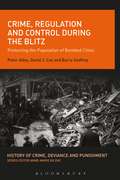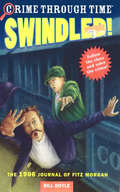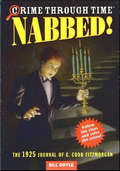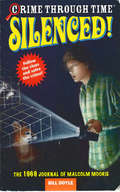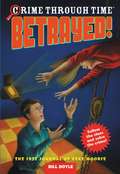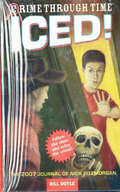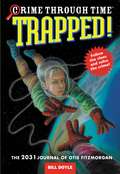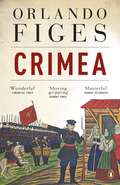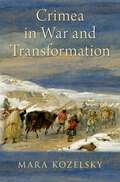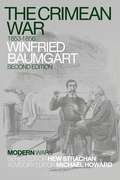- Table View
- List View
Crime, Prosecution and Social Relations: The Summary Courts of the City of London in the Late Eighteenth Century
by D. GrayOffers a fascinating view of the social history of Georgian London through the workings of the Summary courts. By analyzing the summary proceedings and the use of the law by ordinary citizens - to prosecute theft, violence and resolve disputes - this study represents an important addition to our understanding of the criminal justice system.
Crime, Protest and Popular Politics in Southern England, 1740-1850
by John RuleSouthern England has been studied considerably less than the industrializing north and midlands in the debate on the standard of living in the period up to 1850. Yet it is becoming clear that it was in the south and in the countryside that the greatest poverty and deprivation was to be found. These essays examine responses to the struggle to live. The responses ranged from, at the most extreme, sheep-stealing and incendiarism to joining in food riots in an attempt to impose a "moral economy". More sustained protest is to be seen in passive and sometimes active resistance to authority, and in particular in the opposition to the introduction of the New Poor Law of 1834. Finally the appeal yet limitations of Chartism in the south is demonstrated.
Crime, Protest, Community, and Police in Nineteenth-Century Britain (Routledge Library Editions: The History of Crime and Punishment #5)
by David JonesThis study, first published in 1982, is concerned with the nature of crime in nineteenth-century Britain, and explores the response of the community and the police authorities. Each chapter is linked by common themes and questions, and the topics described in detail range from popular forms of rural crime and protest, through crime in industrial and urban communities, to a study of the vagrant. The author pays special attention to the relationship between illegal activities and protest, and emphasizes the context and complexity of official crime rates and of many forms of criminal behaviour. This title will be of interest to students of history and criminology.
Crime, Protest, Community, and Police in Nineteenth-Century Britain (Routledge Library Editions: The History of Crime and Punishment #5)
by David JonesThis study, first published in 1982, is concerned with the nature of crime in nineteenth-century Britain, and explores the response of the community and the police authorities. Each chapter is linked by common themes and questions, and the topics described in detail range from popular forms of rural crime and protest, through crime in industrial and urban communities, to a study of the vagrant. The author pays special attention to the relationship between illegal activities and protest, and emphasizes the context and complexity of official crime rates and of many forms of criminal behaviour. This title will be of interest to students of history and criminology.
Crime, Reason and History: A Critical Introduction to Criminal Law (PDF)
by Alan NorrieMany books seek to explain the rational nature of the criminal law. Crime, Reason and History stands out as a book that critically and concisely analyses the law’s general principles and comes up with a different viewpoint: that the law is shaped by social history and therefore systematically structured around conflicting elements. Updated extensively to include new chapters on loss of control and self-defence and with an extended treatment of offence and defence, this new edition combines challenging and sophisticated analysis with accessibility.
Crime, Regulation and Control During the Blitz: Protecting the Population of Bombed Cities (History of Crime, Deviance and Punishment)
by Peter Adey David J. Cox Barry GodfreyCrime, Regulation and Control during the Blitz looks at the social effect of bombing on urban centres like Liverpool, Coventry and London, critically examining how the wartime authorities struggled to regulate and control crime and offending during the Blitz. Focusing predominantly on Liverpool, it investigates how the authorities and citizens anticipated the aerial war, and how the State and local authorities proposed to contain and protect a population made unruly, potentially deviant and drawn into a new landscape of criminal regulation.Drawing on a range of contemporary sources, the book throws into relief today's experiences of war and terror, the response in crime and deviancy, and the experience and practices of preparedness in anticipation of terrible threats. The authors reveal how everyday activities became criminalised through wartime regulations and explore how other forms of crime such as looting, theft and drunkenness took on a new and frightening aspect. Crime, Regulation and Control during the Blitz offers a critical contribution to how we understand crime, security, and regulation in both the past and the present.
Crime, Regulation and Control During the Blitz: Protecting the Population of Bombed Cities (History of Crime, Deviance and Punishment)
by Peter Adey David J. Cox Barry GodfreyCrime, Regulation and Control during the Blitz looks at the social effect of bombing on urban centres like Liverpool, Coventry and London, critically examining how the wartime authorities struggled to regulate and control crime and offending during the Blitz. Focusing predominantly on Liverpool, it investigates how the authorities and citizens anticipated the aerial war, and how the State and local authorities proposed to contain and protect a population made unruly, potentially deviant and drawn into a new landscape of criminal regulation.Drawing on a range of contemporary sources, the book throws into relief today's experiences of war and terror, the response in crime and deviancy, and the experience and practices of preparedness in anticipation of terrible threats. The authors reveal how everyday activities became criminalised through wartime regulations and explore how other forms of crime such as looting, theft and drunkenness took on a new and frightening aspect. Crime, Regulation and Control during the Blitz offers a critical contribution to how we understand crime, security, and regulation in both the past and the present.
Crime Scenery in Postwar Film and Photography
by Henrik GustafssonThis book offers a rare and innovative consideration of an enduring tendency in postwar art to explore places devoid of human agents in the wake of violent encounters. To see the scenery together with the crime elicits a double interrogation, not merely of a physical site but also of its formation as an aesthetic artefact, and ultimately of our own acts of looking and imagining. Closely engaging with a vast array of works made by artists, filmmakers and photographers, each who has forged a distinct vantage point on the aftermath of crime and conflict, the study selectively maps the afterlife of landscape in search of the political and ethical agency of the image. By way of a thoroughly interdisciplinary approach, Crime Scenery in Postwar Film and Photography brings landscape studies into close dialogue with contemporary theory by paying sustained attention to how the gesture of retracing past events facilitates new configurations of the present and future.
Crime Stories: Criminalistic Fantasy and the Culture of Crisis in Weimar Germany (Monographs in German History #22)
by Todd HerzogThe Weimar Republic (1918–1933) was a crucial moment not only in German history but also in the history of both crime fiction and criminal science. This study approaches the period from a unique perspective - investigating the most notorious criminals of the time and the public’s reaction to their crimes. The author argues that the development of a new type of crime fiction during this period - which turned literary tradition on its head by focusing on the criminal and abandoning faith in the powers of the rational detective - is intricately related to new ways of understanding criminality among professionals in the fields of law, criminology, and police science. Considering Weimar Germany not only as a culture in crisis (the standard view in both popular and scholarly studies), but also as a culture of crisis, the author explores the ways in which crime and crisis became the foundation of the Republic’s self-definition. An interdisciplinary cultural studies project, this book insightfully combines history, sociology, literary studies, and film studies to investigate a topic that cuts across all of these disciplines.
Crime Through Time #1: The 1906 Journal of Fitz Morgan (Crime Through Time Ser. #1)
by Bill DoyleBreathtakingly suspenseful but never violent, this title kicks off a new forensic fiction series for middle grade readers. Young Fitz Morgan unravels a mystery aboard one of the new Continental Express trains in 1906. Readers learn about the real historical setting and actual crime-solving methods from the era. Illustrations.
Crime Through Time #2: The 1925 Journal of G. Codd Fitzmorgan (Crime Through Time Ser. #2)
by Bill DoyleEach book in the Crime Through Time series is hosted by a different child member of the famous Fitzmorgan detective family. While the young sleuth unravels a fictional mystery, readers learn about the real historical setting and actual crime-solving methods from the different eras. In sidebar activities, readers take on the role of assistant, helping to crack the case. Breathtakingly suspenseful but never violent and always age-appropriate, the books read like private investigative journals, with photos, maps, news clippings and crime scene sketches.In book 2, set in 1925, G. Codd Fitzmorgan arrives at a storm-battered mansion for a party. But more than an engagement celebration seems to be afoot, as our detective unravels a mystery involving a seance, a reckless aviator, and sale of liquor banned under Prohibition.
Crime Through Time #3: The 1969 Journal of Malcolm Moorie (Crime Through Time Ser. #3)
by Bill DoyleIn 1969, fourteen-year-old Mal enrolls in a rural California boarding school where he finds himself caught up in a plot involving endangered animals and an illegal pesticide.
Crime Through Time #4: The 1977 Journal of Zeke Moorie (Crime Through Time Ser. #4)
by Bill DoyleWhile working for a traveling disco show accompanying the King Tut exhibition in 1977, fourteen-year-old Zeke investigates a series of mishaps involving the cast and crew, mysterious messages, centuries-old artifacts, and an ancient curse.
Crime Through Time #5: The 2007 Journal of Nick Fitzmorgan (Crime Through Time Ser. #5)
by Bill DoyleEach book in the Crime Through Time series is hosted by a different child member of the famous Fitzmorgan detective family. While the young sleuth unravels a fictional mystery, readers learn about the real historical setting and actual crime-solving methods from the different eras. In sidebar activities, readers take on the role of assistant, helping to crack the case. Breathtakingly suspenseful but never violent and always age-appropriate, the books read like private investigative journals, with photos, maps, news clippings and crime scene sketches.In book 5, set in 2007, Nick Fitzmorgan unexpectedly returns home early from detective training camp, only to find his screenwriter father vanished and the house in disarray. The house isn't just messy, though: it's carefully set up with clues that will lead Nick all the way to Everest, and his father's rescue.
Crime Through Time #6: The 2031 Journal of Otis Fitzmorgan (Crime Through Time Ser. #6)
by Bill DoyleEach book in the Crime Through Time series is hosted by a different child member of the famous Fitzmorgan detective family. While the young sleuth unravels a fictional mystery, readers learn about the real historical setting and actual crime-solving methods from the different eras. In sidebar activities, readers take on the role of assistant, helping to crack the case. Breathtakingly suspenseful but never violent and always age-appropriate, the books read like private investigative journals, with photos, maps, news clippings and crime scene sketches.In book 6, set in 2031, Otis Fitzmorgan finds himself in the middle of an evil art fraud mystery in space. On his way back to earth via the new space elevator Otis is forced to use his outlawed private detective skills to get to the bottom of the mystery that is threatening to kill all of those on board.
Crime Watching: Investigating Real Crime TV
by Deborah JermynIn recent years reality TV formats have proliferated on television. One of the most significant and controversial strands within this has been the growth of 'real crime TV'. Encapsulating everything from crime appeal shows to reconstruction programmes and actuality footage shows, real crime TV now plays a major role in our television schedules, filling countless hours of air-time every week. Crime Watching examines the spectacular growth of real crime TV, arguing that the birth of the BBC's Crimewatch UK in 1984 was a key transitional moment in the emergence, expansion and subsequent popularity of these programmes both in the UK and internationally. Deborah Jermyn looks closely at the social and political context of the period in which Crimewatch UK first appeared and examines the aesthetics, address and appeal of a range of other shows appearing in its wake, including Police Camera Action!, America's Most Wanted and World's Wildest Police Videos. She investigates the conditions that have advanced the ubiquity of real crime programming on contemporary television and the anxieties that surround it. Examining critiques that real crime TV has increased fear of crime while legitimising a surveillance culture, and that it serves to stifle debate about criminality and policing, Crime Watching also reflects on the pleasures of these programmes and the enduring nature of our culture's seemingly endless fascination with real crime stories.
Crimea: The Last Crusade
by Orlando FigesThe terrible conflict that dominated the mid 19th century, the Crimean War killed at least 800,000 men and pitted Russia against a formidable coalition of Britain, France and the Ottoman Empire. It was a war for territory, provoked by fear that if the Ottoman Empire were to collapse then Russia could control a huge swathe of land from the Balkans to the Persian Gulf. But it was also a war of religion, driven by a fervent, populist and ever more ferocious belief by the Tsar and his ministers that it was Russia's task to rule all Orthodox Christians and control the Holy Land.Orlando Figes' major new book reimagines this extraordinary war, in which the stakes could not have been higher and which was fought with a terrible mixture of ferocity and incompetence. It was both a recognisably modern conflict - the first to be extensively photographed, the first to employ the telegraph, the first 'newspaper war' - and a traditional one, with illiterate soldiers, amateur officers and huge casualties caused by disease. Drawing on a huge range of fascinating sources, Figes also gives the lived experience of the war, from that of the ordinary British soldier in his snow-filled trench, to the haunted, gloomy, narrow figure of Tsar Nicholas himself as he vows to take on the whole world in his hunt for religious salvation.
Crimea and the Black Sea: An Environmental History (Environmental History and Global Change)
by Carlos CordovaCrimea has a rich and varied history. Mentioned in the writings of Strabo, Herodotus and Pliny the Elder, it was colonized by the Huns, the Goths and the Mongols and was part of the Roman, Byzantine and Venetian empires, until it annexed by Russia in the eighteenth century. It suffered in the Crimean War, saw bloody battles in the Second World War and was transferred to the Ukraine by Khrushchev in the 1950s. Most recently it has drawn international attention as it was once more annexed by Russia in its dispute with Ukraine.The environmental history of Crimea is similarly complex. Formerly known as the Tauric Peninsula, its landscape of plains, piedmont and mountains, is surrounded to the east by the Azov Sea, to the north by the Sivash lagoonal system and to the south and west by the Black Sea. The Black Sea in particular has had a major impact on nearly all aspects of Crimea's natural and cultural history, from the impact of its flooding in prehistoric times to the environmental pollution problems of the modern era. Carlos Cordova explains the making of Crimea's natural environment, from its geology and relief to its climate and soils. He explores the rich flora and fauna of the peninsula, including the biogeographical isolation of Crimea, its endemic and relict species, as well as the struggle to protect species and their habitats. He details the transformation of the landscape brought about by Greek farmers and other Mediterranean groups, as well as the marked changes resulting from Khrushchev's Virgin Lands Campaign, which saw virtually all the steppe trurned into cropland. The development of the south coast – the so-called Russian Riviera – as a tourist destination and the pollution brought about by the development of agriculture and industry are also included. The strategic importance of Crimea as a site for many Russian naval bases has meant that there has been little access to the region and it is poorly known in the west. With the collapse of the Soviet Union the situation changed. Making full use of the new accessibility, and drawing on almost two decades of research in Crimea, Carlos Cordova's pioneering study represents the first modern work in the English language on the environmental history of this little known but environmentally significant region.
Crimea, Global Rivalry, and the Vengeance of History
by Hall GardnerGardner examines the causes and consequences of Russia's annexation of Crimea. By analyzing alliance formations and the consequences of other annexations in world history, the book urges an alternative US-NATO-European-Japanese strategy toward both Russia and China in the effort to prevent a renewed arms race, if not global war.
Crimea in War and Transformation
by Mara KozelskyCrimea in War and Transformation is the first book to examine the terrible toll of violence on Crimean civilians and landscapes from mobilization through reconstruction. When war landed on Crimea's coast in September 1854, multiple armies instantly doubled the peninsula's population. Engineering brigades mowed down forests to build barracks. Ravenous men fell upon orchards like locusts and slaughtered Crimean livestock. Within a month, war had plunged the peninsula into a subsistence crisis. Soldiers and civilians starved as they waited for food to travel from the mainland by oxcart at a rate of ½ mile per hour. Every army conscripted Tatars as laborers, and fired upon civilian homes. Several cities and villages-Sevastopol, Kerch, Balaklava, Genichesk among them-burned to the ground. At the height of violence, hysterical officers accused Tatars of betrayal and deported large segments of the local population. Peace did not bring relief to Crimea's homeless and hungry. Removal of dead bodies and human waste took months. Epidemics swept away young children and the elderly. Russian officials estimated the devastation wrought by Crimean War exceeded that of Napoleon's invasion. Recovery packages failed human need, and by 1859, the trickle of Tatar out-migration that had begun during the war turned into a flood. Nearly 200,000 Tatars left Crimea by 1864, adding a demographic crisis to the tally of war's destruction. Drawing from a wide body of published and unpublished material, including untapped archives, testimonies, and secret police files from Russia, Ukraine and Crimea, Mara Kozelsky details in readable and vivid prose the toll of war on the Crimean people, and the Russian Empire as a whole, from mobilization through failed efforts at reconstruction.
Crimea in War and Transformation
by Mara KozelskyCrimea in War and Transformation is the first book to examine the terrible toll of violence on Crimean civilians and landscapes from mobilization through reconstruction. When war landed on Crimea's coast in September 1854, multiple armies instantly doubled the peninsula's population. Engineering brigades mowed down forests to build barracks. Ravenous men fell upon orchards like locusts and slaughtered Crimean livestock. Within a month, war had plunged the peninsula into a subsistence crisis. Soldiers and civilians starved as they waited for food to travel from the mainland by oxcart at a rate of ½ mile per hour. Every army conscripted Tatars as laborers, and fired upon civilian homes. Several cities and villages-Sevastopol, Kerch, Balaklava, Genichesk among them-burned to the ground. At the height of violence, hysterical officers accused Tatars of betrayal and deported large segments of the local population. Peace did not bring relief to Crimea's homeless and hungry. Removal of dead bodies and human waste took months. Epidemics swept away young children and the elderly. Russian officials estimated the devastation wrought by Crimean War exceeded that of Napoleon's invasion. Recovery packages failed human need, and by 1859, the trickle of Tatar out-migration that had begun during the war turned into a flood. Nearly 200,000 Tatars left Crimea by 1864, adding a demographic crisis to the tally of war's destruction. Drawing from a wide body of published and unpublished material, including untapped archives, testimonies, and secret police files from Russia, Ukraine and Crimea, Mara Kozelsky details in readable and vivid prose the toll of war on the Crimean people, and the Russian Empire as a whole, from mobilization through failed efforts at reconstruction.
The Crimean Nexus: Putin's War and the Clash of Civilizations
by Constantine PleshakovHow the West sleepwalked into another Cold War A native of Yalta, Constantine Pleshakov is intimately familiar with Crimea’s ethnic tensions and complex political history. Now, he offers a much-needed look at one of the most urgent flash points in current international relations: the first occupation and annexation of one European nation’s territory by another since World War II. Pleshakov illustrates how the proxy war unfolding in Ukraine is a clash of incompatible world views. To the U.S. and Europe, Ukraine is a country struggling for self-determination in the face of Russia’s imperial nostalgia. To Russia, Ukraine is a “sister nation,” where NATO expansionism threatens its own borders. In Crimea itself, the native Tatars are Muslims who are vehemently opposed to Russian rule. Engagingly written and bracingly nonpartisan, Pleshakov’s book explains the missteps made on all sides to provide a clear, even-handed account of a major international crisis.
The Crimean Tatars: From Soviet Genocide to Putin's Conquest
by Brian Glyn WilliamsThe Russian annexation of the Crimea in March 2014 focused the world's attention on the Peninsula in ways not seen since the Crimean War. Thousands of Crimean Tatars clashed with pro-Russian militiamen in Simferopol, while Moscow has in turn stoked fears of jihadi terrorism among the overwhelmingly Muslim Tatars as retrospective justification for its invasion. The key thread in this book is the Crimean Tatars' changing relationship with their Vatan (homeland) and how this interaction with their natal territory changed under the Ottoman Sultans, Russian Tsars, Soviet Commissars, post-Soviet Ukrainian authorities and now Putin's Russia. Taking as its starting point the 1783 Russian conquest of the independent Tatar state known as the Crimean Khanate, Williams explains how the peninsula's native population, with ethnic roots among the Goths, Kipchak Turks, and Mongols, was scattered across the Ottoman Empire. He also traces their later emigration and the radical transformation of this conservative tribal-religious group into a modern, politically mobilized, secular nation under Soviet rule. Stalin's genocidal deportation of the Crimean Tatars in 1944 to Uzbekistan and their almost messianic return to their cherished 'Green Isle' in the 1990s are examined in detail, while the author's archival investigations are bolstered by his field research among the Crimean Tatar exiles in Uzbekistan and in their samozakhvat (self-seized) squatter camps and settlements in the Crimea.
The Crimean Tatars: From Soviet Genocide to Putin's Conquest
by Brian Glyn WilliamsThe Russian annexation of the Crimea in March 2014 focused the world's attention on the Peninsula in ways not seen since the Crimean War. Thousands of Crimean Tatars clashed with pro-Russian militiamen in Simferopol, while Moscow has in turn stoked fears of jihadi terrorism among the overwhelmingly Muslim Tatars as retrospective justification for its invasion. The key thread in this book is the Crimean Tatars' changing relationship with their Vatan (homeland) and how this interaction with their natal territory changed under the Ottoman Sultans, Russian Tsars, Soviet Commissars, post-Soviet Ukrainian authorities and now Putin's Russia. Taking as its starting point the 1783 Russian conquest of the independent Tatar state known as the Crimean Khanate, Williams explains how the peninsula's native population, with ethnic roots among the Goths, Kipchak Turks, and Mongols, was scattered across the Ottoman Empire. He also traces their later emigration and the radical transformation of this conservative tribal-religious group into a modern, politically mobilized, secular nation under Soviet rule. Stalin's genocidal deportation of the Crimean Tatars in 1944 to Uzbekistan and their almost messianic return to their cherished 'Green Isle' in the 1990s are examined in detail, while the author's archival investigations are bolstered by his field research among the Crimean Tatar exiles in Uzbekistan and in their samozakhvat (self-seized) squatter camps and settlements in the Crimea.
The Crimean War: 1853-1856 (Modern Wars)
by Winfried BaumgartWinfried Baumgart's masterful history of the Crimean War has been expanded and fully updated to reflect advances made in the field since the book's first publication. It convincingly argues that if the war had continued after 1856, the First World War would have taken place 60 years earlier, but that fighting ultimately ceased because diplomacy never lost its control over the use of war as an instrument in power politics.With 19 images, 13 maps and additional tables as well as a brand new chapters on 'the medical services', this expanded and fully-updated 2nd edition explores* The origins and diplomacy of the Crimean War* The war aims and general attitudes of the belligerent powers (Russia, France, and Britain), non-belligerent German powers (Austria and Prussia) and a selected number of neutral powers, including the United States* The characteristics and capabilities of the armies involved* The nature of the fighting itselfThe Crimean War: 1853-1856 examines the conflict in both its Europe-wide and global contexts, moving beyond the five great European powers to consider the role and importance of smaller states and theatres of war that have otherwise been under-served. To this end, it looks at fighting on the Danube front, the Black Sea, the Baltic Sea, the Caucasian battlefield, as well as the White Sea and the Pacific, with final chapters devoted to the Paris peace congress of 1856, the end of the war and its legacy.This book remains the definitive study of one of the most important wars in modern history.




